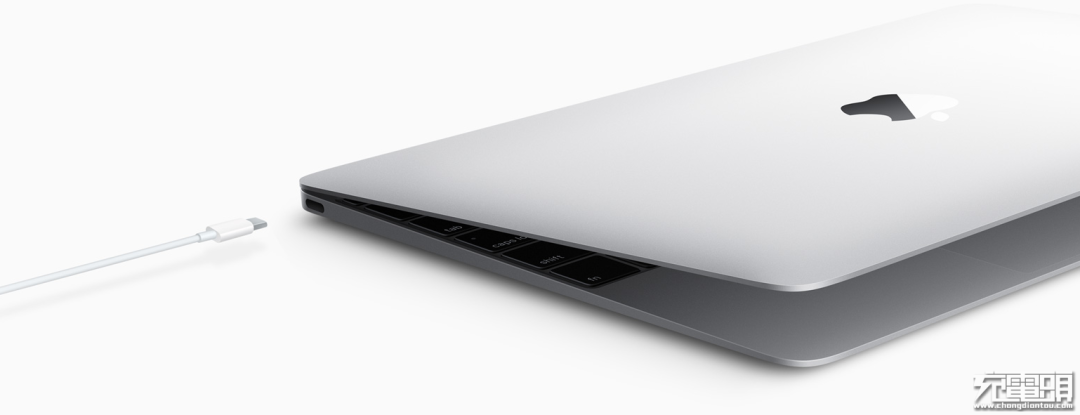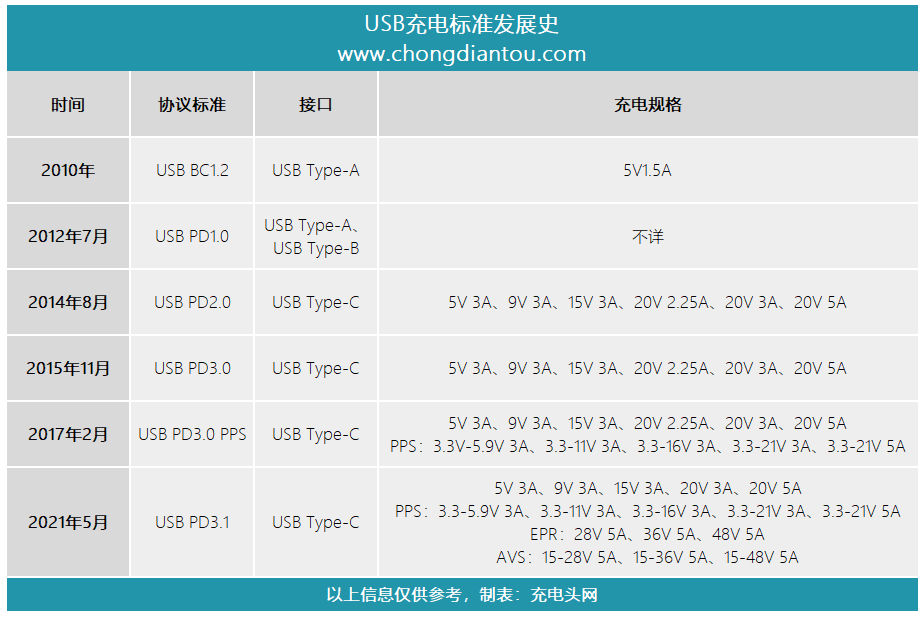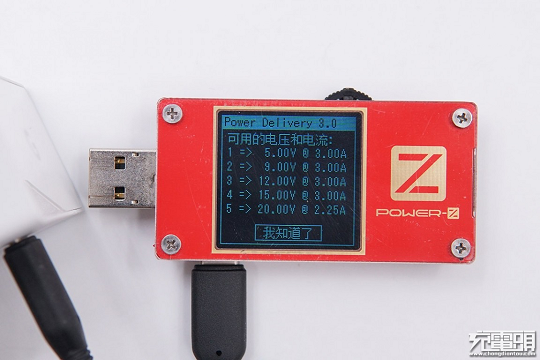Understand the differences between USB pd2.0, 3.0 and 3.1 in one article
Time:2022-08-03
Views:1926
Recently, the usb-if Association released the latest USB pd3.1 fast charging standard. The charging power was increased from the original 100W to 240W, and the maximum 48V voltage output was supported. For a time, it received widespread attention and caused heated discussion in the industry.

Literally, USB pd3.1 can only be regarded as a small version update of USB pd3.0, but in terms of power, this is a qualitative leap. What are the differences between USB pd3.1 and previous versions? Today, the Xiaobian of charging head network will come to smooth it out with you.

USBPD2.0
USB pd2.0 fast charging standard was released in August 2014. It not only stipulates that USB type-C interface is the only standard interface, but also gives this interface more functions, such as charging, data transmission, audio transmission, etc. In terms of charging, USB pd2.0 defines that it supports 5v3a, 9v3a, 12v3a, 15v3a and 20v5a outputs, and the maximum charging power reaches 100W.

However, it was still the era when micro USB interface was popular, and the mobile phone market had been basically divided up by private fast charging protocols such as QC, AFC, FCP, PE, etc., so it was difficult to popularize USB PD fast charging. This situation lasted until 2015, when Apple released the industry‘s first new MacBook equipped with USB pd2.0 fast charging standard, and USB PD fast charging officially opened the road to popularity in the field of consumer power supplies.
USB PD3.0

Simply put, from the perspective of charging parameters, USB pd3.0 and USB pd2.0 have not changed. They still support 5v3a, 9v3a, 12v3a, 15v3a and 20v5a outputs, with a maximum power of 100W. However, this update has not improved the chaotic situation of fast charging standards in the mobile phone market. Fast charging standards are still independent and incompatible with each other.
USB PD3.0 PPS
In order to change the split situation of the fast charging protocol in the mobile phone market, the usb-if Association released an important update of the USB pd3.0 standard in February 2017, adding a programmable power supply PPS on the basis of the USB pd3.0 standard.

PPS is a type of power supply supported in USB pd3.0. It is a power supply that can realize voltage and current regulation using USB PD protocol output. PPS specification integrates the current two charging modes of high voltage low current and low voltage high current. The voltage amplitude modulation drop is also 20mV, which is only one tenth of the qc3.0 standard at that time, and the adjustment is more accurate.
USB PD3.1

PPS is a type of power supply supported in USB pd3.0. It is a power supply that can realize voltage and current regulation using USB PD protocol output. PPS specification integrates the current two charging modes of high voltage low current and low voltage high current. The voltage amplitude modulation drop is also 20mV, which is only one tenth of the qc3.0 standard at that time, and the adjustment is more accurate.
USB PD3.1

Literally, USB pd3.1 can only be regarded as a small version update of USB pd3.0, but in terms of power, this is a qualitative leap. What are the differences between USB pd3.1 and previous versions? Today, the Xiaobian of charging head network will come to smooth it out with you.

USBPD2.0
USB pd2.0 fast charging standard was released in August 2014. It not only stipulates that USB type-C interface is the only standard interface, but also gives this interface more functions, such as charging, data transmission, audio transmission, etc. In terms of charging, USB pd2.0 defines that it supports 5v3a, 9v3a, 12v3a, 15v3a and 20v5a outputs, and the maximum charging power reaches 100W.

However, it was still the era when micro USB interface was popular, and the mobile phone market had been basically divided up by private fast charging protocols such as QC, AFC, FCP, PE, etc., so it was difficult to popularize USB PD fast charging. This situation lasted until 2015, when Apple released the industry‘s first new MacBook equipped with USB pd2.0 fast charging standard, and USB PD fast charging officially opened the road to popularity in the field of consumer power supplies.
USB PD3.0
In November 2015, USB PD fast charging ushered in a major version update, entering the era of USB pd3.0 fast charging. The changes of USB pd3.0 compared with USB pd2.0 mainly include three aspects: a more detailed description of the characteristics of the built-in battery of the device is added; The functions of software and hardware version identification and software update through PD communication are added, as well as the functions of digital certificate and digital signature.

Simply put, from the perspective of charging parameters, USB pd3.0 and USB pd2.0 have not changed. They still support 5v3a, 9v3a, 12v3a, 15v3a and 20v5a outputs, with a maximum power of 100W. However, this update has not improved the chaotic situation of fast charging standards in the mobile phone market. Fast charging standards are still independent and incompatible with each other.
USB PD3.0 PPS
In order to change the split situation of the fast charging protocol in the mobile phone market, the usb-if Association released an important update of the USB pd3.0 standard in February 2017, adding a programmable power supply PPS on the basis of the USB pd3.0 standard.

PPS is a type of power supply supported in USB pd3.0. It is a power supply that can realize voltage and current regulation using USB PD protocol output. PPS specification integrates the current two charging modes of high voltage low current and low voltage high current. The voltage amplitude modulation drop is also 20mV, which is only one tenth of the qc3.0 standard at that time, and the adjustment is more accurate.
In addition, usb-if association also reached a consensus with Theil laboratory, aiming to unify the fast charging technology of PPS fast charging standard. At present, PPS fast charging has become a fast charging standard with a very high share in the Android mobile phone camp. Combined with the built-in charge pump of the mobile phone, it can achieve high-efficiency and high-power fast charging. Models of Xiaomi, Samsung, Meizu and other brands are in use.
USB PD3.1
USB pd3.1 is the fast charging standard just released by the usb-if Association. The USB pd3.1 fast charging standard is actually an update based on USB pd3.0 PPS fast charging.

PPS is a type of power supply supported in USB pd3.0. It is a power supply that can realize voltage and current regulation using USB PD protocol output. PPS specification integrates the current two charging modes of high voltage low current and low voltage high current. The voltage amplitude modulation drop is also 20mV, which is only one tenth of the qc3.0 standard at that time, and the adjustment is more accurate.
In addition, usb-if association also reached a consensus with Theil laboratory, aiming to unify the fast charging technology of PPS fast charging standard. At present, PPS fast charging has become a fast charging standard with a very high share in the Android mobile phone camp. Combined with the built-in charge pump of the mobile phone, it can achieve high-efficiency and high-power fast charging. Models of Xiaomi, Samsung, Meizu and other brands are in use.
USB PD3.1
USB pd3.1 is the fast charging standard just released by the usb-if Association. The USB pd3.1 fast charging standard is actually an update based on USB pd3.0 PPS fast charging.
|
Disclaimer: This article is transferred from other platforms and does not represent the views and positions of this site. If there is infringement or objection, please contact us to delete. thank you! |











